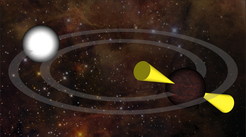Einstein@Home detects unusual stellar pair
The neutron star and its companion could prove helpful in testing the general theory of relativity
Neutron stars are quite unique: the material they are made of is packed much more densely than conventional matter. They rotate extremely fast about their own axis, emitting radiation in the process, so they are often visible as pulsars in the radio spectrum. Researchers at the Max Planck Institute for Gravitational Physics in Hanover, working as part of the international PALFA Collaboration, and with the help of participants in the Einstein@Home project, have now discovered a pulsar accompanied by a white dwarf – a burnt-out star. The researchers want to weigh the pair, using what is known as the Shapiro effect.
When faced with tricky questions relating to the general theory of relativity, scientists usually look in the universe for answers. Even then, it is often very difficult to filter out the right astrophysical objects from the plethora of data. That is why scientists call on volunteers to help them in the time-consuming process of analysing data, making unused computing power on their home or office computers available for projects like Einstein@Home.
Armed with this support, the research group headed by Bruce Allen, Director at the Max Planck Institute for Gravitational Physics (Albert Einstein Institute/AEI), Hanover, along with colleagues from the PALFA Collaboration, discovered radio pulsar J1952+2630. The researchers found it in data from the Arecibo telescope. "I'm very excited that the Einstein@Home team has discovered another exotic radio pulsar. These amazing objects are so extreme that if they were crushed to one-third of their size, they would collapse to form black holes. And a big "thank you" to our thousands of volunteers: we'd be nowhere without their contributions," says Allen.

J1952+2630 flashes every 20.7 milliseconds, and is around 31,000 light-years from Earth. From the radio pulse modulation, the astronomers concluded that the pulsar has a partner star with at least 95 per cent of the Sun’s mass. These two celestial bodies revolve around their common centre of gravity, orbiting once every 9.4 hours in what are virtually perfect circles.
From the shape of their orbits, the astrophysicists can draw important conclusions as to what the companion is like and how it came to exist, even though they can’t see it directly. It is probably a (relatively heavy) white dwarf – an expired star that was once quite ordinary, like our Sun. At the end of its life, it blew up into a red giant and cast off its outer layer of matter, some of which the neutron star then absorbed.
The two stars also exchanged (orbital) angular momentum, which is how they came to have perfectly circular orbits. Had this star formerly had a much greater mass than the Sun, then it, too, would have exploded into a supernova at the end of its life, and become a neutron star. The momentum generated in this process would have kicked it into an asymmetric elliptical orbit.
Astronomers currently know of 1,900 pulsars, single stars included.
The combination of a neutron star and a rather massive white dwarf orbiting one another in a perfect circle is rare. White dwarfs orbiting like this usually have a mass of just 10% to 30% of the mass of the Sun. And just half a dozen of the hundred or so known binary star systems with pulsars are like this.
“Thanks to the relatively high mass of the companion, this binary star system will presumably be suited to testing a phenomenon of general relativity, namely the gravitational time delay of light,” says Allen’s Ph.D. student Benjamin Knispel. “Which means we could also determine the precise mass of each component.”
This effect, also known as the Shapiro delay, occurs when visible light or radio waves pass through a gravitational field, for instance that of a star, on their way through the universe. The gravitational field diverts these beams from their straight path. But this means the light takes longer to make the detour. When the white dwarf moves into the line of sight between the pulsar and the Earth, the radio pulses which are emitted by the neutron star in regular intervals must travel further and further.
The pulses thus reach the observer at ever-increasing time intervals. “To measure this, we need to look at the system from the side, if possible – that is, at the edge of the plane of orbit – so that, in certain configurations, the radio pulses from the neutron star pass through the white dwarf’s gravitational field on their way to us,” says Knispel. This method can be used to weigh the two stars. Knispel and his colleagues are already planning the next observations to do just that.
Additional information:
The pulsar ALFA (PALFA) Consortium was founded in 2003 with the aim of conducting a large-scale pulsar survey with the Arecibo telescope. It includes astronomers from 20 universities, institutes and observatories worldwide.
Einstein@Home, with more than 290,000 participants, is one of the largest distributed computing projects in the world. It was set up in 2005 and has been searching for gravitational waves amongst the data from the detectors of the international LIGO/Virgo/GEO collaboration. Since 2009, it has been using 35 per cent of its available computing power to support the work of the PALFA Collaboration.
The two amateur scientists whose computers found the strongest signal in the data analysis are Vitaly V. Shiryaev (Moscow, Russia) and Stacey Eastham (Darwen, Great Britain), who are credited by name and thanked in the publication.












